50 Tips for Truck Drivers
Truck drivers cover thousands of miles each year. To ensure safer travels, it’s important to drive cautiously, maintain extra space between vehicles, and be ready to stop. Always follow work zone signs, watch for shifting traffic patterns, and stay aware of your blind spots, as well as road workers. Additionally, conduct inspections before and after trips, follow speed limits, avoid distractions, and ensure your cargo is properly loaded.
Explore the complete list of tips to help you stay safer, more comfortable, and reduce the risk of accidents.
Home » 50 Tips for Truck Drivers
More than 1.4 million people work as truck drivers, making this a popular profession in the United States. For people who enjoy the road, truck driving can be a very fulfilling career. Review the following to make the experience safer and more rewarding.
Safety on the Road
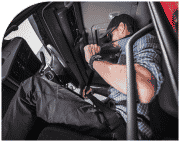
1. Wear Your Seatbelt
Seatbelts save lives, and the laws in many states require you to wear seatbelts. Don’t give police officers an excuse to pull you over because you aren’t wearing a seatbelt.
2. Avoid Distractions and Cell Phone Use
If you need to send a text, read a text, or make a phone call, pull over and stop first. Anything that causes you to take your eyes off the road is dangerous. When you are driving a multi-ton truck, you want to avoid any distractions that might cause an accident.


3. Follow the Hours of Service Rules
FMCSA rules require that you take at least a 30-minute break after eight cumulative hours of driving and require that you are off duty for at least 10 hours a day. Breaking those rules causes fatigue, which could increase the potential for accidents. These are only minimum requirements—the more breaks you take, the safer you will be.
4. Defensive Driving
Stay aware of your surroundings at all times and drive predictably. You can’t control other drivers, but you can reduce the likelihood that they will strike your truck if you drive carefully.


5. Watch Your Blind Spots
According to a study performed at the University of Michigan, most fatal crashes that involve heavy trucks are not the trucker’s fault. Unfortunately, this just means you need to be extra aware of reckless drivers. By regularly checking your mirrors, you can maintain awareness of the vehicles driving near your truck and take appropriate action.
6. Keep Lane Changes to a Minimum
Lane changes have the potential to be quite dangerous, particularly if a vehicle has slipped into your blind spot. You should change lanes as little as possible and always signal well in advance of making a lane change. This gives other vehicles plenty of time to get out of your way.


7. Be Aware of Local Laws
Traffic laws change with every state you drive through. Familiarize yourself with any laws that specifically affect you before entering a state. If you are unsure, be conservative, drive slowly and stay in the right lane as much as possible.
8. Use GPS Units for Trucking
Google Maps is an excellent resource for regular drivers, but truck drivers should not rely on a car GPS. A truck GPS is specially designed to choose routes that will accommodate the height and weight of your vehicle.


9. Drive at a Safe Speed
Speeding is a common cause of truck accidents. Because you have a schedule to keep, you might feel tempted to speed. But you’ll lose a lot more time if you get pulled over for speeding. Stay under posted truck speed limits at all times. Be aware that you will need to slow down even more when going downhill because your truck will naturally speed up.
10. Watch Steep Hills and Use Auxiliary Brakes
Overusing your brakes might cause brake failure, which is extremely dangerous when driving a truck. If a hill has a steep hill warning or a reduced truck speed, you should probably use your auxiliary brakes to protect your brakes. You should definitely use them on any hill with an emergency runaway truck ramp.
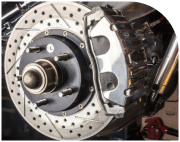

11. Plan Your Trip
12. Keep a Safe Distance
Large trucks could need up to the length of two football fields to come to a safe stop. Whenever possible, you should keep plenty of room between you and the vehicles in front of you, even if this requires you to slow down to make additional room.


13. Make Wide Turns Carefully
Nearly all turns for a truck are wide turns. Before making any turns, slow down, signal early and triple-check all blind spots. Even with those precautions, you may be in danger while turning, so make sure you are ready to stop safely if necessary.
14. Use Your Signal
You are driving a cumbersome beast that makes very wide turns. While you can’t control everything on the road, you can give other drivers plenty of warning before you make any turns, giving them more time to get out of the way. The same is true when you are trying to switch lanes.
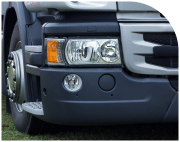
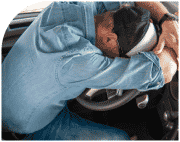
15. Get Rest
Many truck drivers are on the road for 14 hours a day and then try to fit a full social life into the remaining 10 hours. This is a recipe for chronic fatigue. Take plenty of breaks and get a full night’s sleep every night.
16. Eat Healthy


17. Watch OTC Drugs and Know Their Effects
If you have allergies, you may feel tempted to take Benadryl to deal with the symptoms. But Benadryl also causes drowsiness, which presents a danger while driving. Pay attention to the side effects of all over-the-counter drugs before taking them. Do not operate a truck while taking opioids.
18. Take Enough Breaks
Regulations require that you take one 30-minute break a day, but taking just one break isn’t great for your health. You will be less fatigued and more comfortable if you take regular breaks throughout the day, especially if you get a little exercise or stretching done during those breaks.

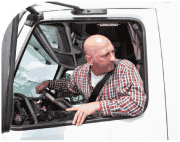
19. Wear Comfortable Clothing
20. Consider the Effects of Road Vibrations

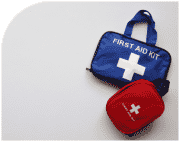
21. Have an Emergency Kit
All trucks should have an emergency kit with medical supplies, blankets, food and water. This kit is your lifeline if you get hurt or if you get stuck somewhere for a few days.
22. Take Breaks in Parking Lots or Rest Areas (Not on the Shoulder)


23. Be Cautious in Work Zones and School Zones
24. Scan Ahead


25. Have a Dash Cam
26. Communicate Whereabouts to Dispatcher and Friends
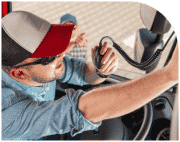
At the Truck Stops/Parking
27. Get Out and Look (G.O.A.L.)
Before backing your truck, get out of the truck and look around. This ensures that you are aware of—and can avoid—any dangers while backing up.
28. Lock Your Loads
An unaccompanied truck is often a target for robbery. Any time you stop, confirm that your truck is securely locked. This is doubly important if you intend to walk away from your truck.
29. Lock All Doors to Avoid Break-Ins When at Truck Stops
Your cargo isn’t the only thing that can get robbed when you stop for a break. Somebody might break into your truck for the money, supplies or even your radio. Lock every single door whenever you leave your truck.
30. Check Out the Delivery Spot
Just because a customer or shipper says your truck can fit in a delivery spot, don’t take their word for it. Check it out on foot first, confirming that your truck can safely fit into and exit the spot and won’t block traffic.
31. Choose Your Truck Stops Wisely
Not all truck stops are safe. If a truck stop doesn’t have good lighting or is empty, it could be dangerous. Plan to stop only at safe truck stops and always park near other trucks when possible. Keep an eye out for signs of human trafficking at truck stops.
32. Careful When Unloading Freight
There are multiple dangers when you unload freight. You could injure yourself, damage the freight or even be robbed. Take care to protect yourself and your cargo when unloading freight.
33. Secure Your Doors When Sleeping at Night
Your truck is in roughly as much danger while you are sleeping as it is when you aren’t present. Fully secure your doors while you sleep to prevent anyone from robbing your truck or assaulting you while you sleep.
34. Don’t Talk About Your Load in Public or Over the Radio
You are less likely to be robbed if nobody but you and your client knows the value of your load. Avoid telling anyone what you are carrying. A potential thief is much less likely to try to steal your load if they can’t be certain that your truck isn’t empty or carrying something of minimal value.
Checking Your Truck
Inspect the Engine Compartment
Before every trip, you should perform an inspection of your truck. When you’re taking a look at the engine compartment, check all fluids, belts and wiring insulation for wear or low levels.
Check Tires
Your tires will get a lot of use. Check carefully for any objects embedded in them, like nails, that could lead to a blowout. Also, check the pressure and tire tread, replacing any tires as necessary.
Check Your Load
Make sure that your load is well secured and isn’t missing anything. And always make certain you have the correct load. The last thing you want to do is drive 2,000 miles only to deliver the wrong load.
Check Fluid Levels
Check your oil, coolant, power steering fluid, brake fluid and windshield wiper fluid levels before every trip.
Check for Dripping Coolant or Oil
This check should be relatively easy. Move your truck a few feet after it has been sitting for at least a few hours. If there is a puddle on the ground, you are likely leaking something.
Inspect Your Brakes
Your brakes are extremely important to the safety of your truck. Check your brake lining for the appropriate thickness, ensure that air lines aren’t damaged and check your brakes for proper alignment. If there is any hint of damage or wear, replace the appropriate part immediately.
Check Your Lights and Reflectors
Check every single headlight, brake light, warning light and turn signal to make sure they work properly. This check will be easier when it is darker. Also, check your reflectors for damage.
Careful When Exiting Vehicle
No matter how much of a hurry you are in, make sure you have three points of contact at all times while exiting your vehicle. Never jump from the cab to the ground, and look closely to make sure you aren’t stepping on something slippery.
Inspect the Coupling System
If the coupling system fails while you are driving, your trailer could release while on the road. Check the fifth wheel, air lines, gap, mounting bolt and locking jaws to ensure they don’t have any damage and are in the correct positions.
Watch Out for Weather
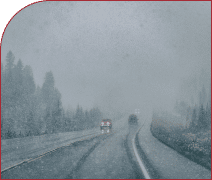
44. Don’t Drive in Poor Visibility
Remember that it takes roughly 600 feet to stop your vehicle. If you can’t see at least that far ahead of you at all times, you shouldn’t even consider driving. Always drive slowly when visibility is reduced in any way to avoid rear-end truck accidents.

45. Driving in Intense Heat Can Cause Tire Bursts
Your tires are under a lot of pressure, and when air heats up, it expands. In extremely high heat, your tires may burst. Give your tires plenty of breaks if you must drive in high heat.

46. Park in Cases of Impassable Snow
If heavy snow has forced you to stop, you may not be able to get to a safe place. Park your truck and keep it running to prevent fluids from freezing. Keep flashing lights on to stay visible and prevent others from striking you. You should also report your location to emergency services if possible.

47. Watch Out for Black Ice
Even with chains on your tires, your truck can’t gain much traction on ice. Since black ice is essentially invisible, you need to drive very slowly and carefully any time there is a risk of black ice. If you believe there is a lot of ice on the road, pull over and wait for state services to remove the ice.

48. Wear Sunglasses When Appropriate
There are sunglasses, and then there are sunglasses. Good sunglasses may cost a few hundred dollars, but they will protect your eyes a lot better than cheap sunglasses and should last for years. Just make sure to take them off at night.

49. Be Extra Cautious at Night
In addition to decreased visibility, nighttime driving presents dangers that you are less likely to face during the day, such as animals that only come out at night.

50. Watch Wind Conditions
High winds can cause your truck to roll over, especially when driving over bridges. If you feel your truck start to sway even a little due to wind, pull over immediately and wait out the wind.
Experienced Legal Representation After an Accident
Reach out to the team of experienced truck accident lawyers at The Lanier Law Firm. Truck accident claims are complex, and we work on your behalf to obtain and review evidence including black boxes, training records, logbooks, maintenance records, and anything else we can find to help you obtain maximum compensation.
By submitting this form, you agree to our terms & conditions. Please read the full disclaimer



